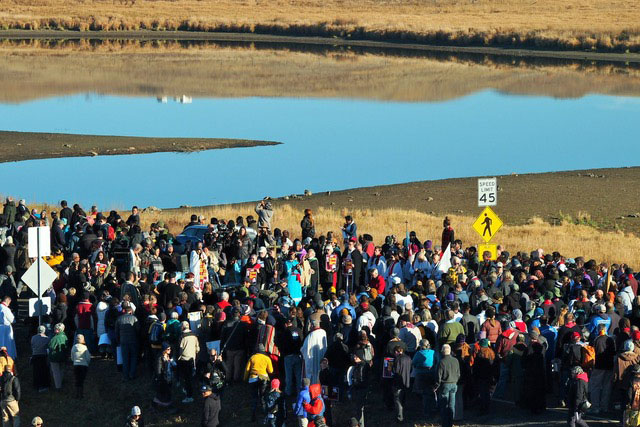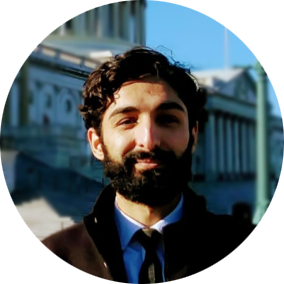Standing Rock: Law, Religion, and Morality in Contested Spaces
Kamil Jamil
“Sacred Stone Camp” by Tony Webster / Flickr / CC BY 2.0
The Standing Rock demonstrations, which began in early 2016 and lasted almost a year, have been aptly characterized as the largest Native American activist movement in modern history.1 Daniel A. Medina, “Dakota Access Pipelne: What’s Behind the Protests?,” NBC News, November 4, 2016, https://www.nbcnews.com/storyline/dakota-pipeline-protests/dakota-access-pipeline-what-s-behind-protests-n676801 (describing Standing Rock as the largest Native American protest movement in modern history). Catherine Thorbecke, “Timeline of the Dakota Access Pipeline Protests,” ABC News,October 28, 2016, https://abcnews.go.com/US/timeline-dakota-access-pipeline-protests/story?id=43131355 (describing the starting date of the protest around April 2016). Julia Carrie, “Police Remove Last Standing Rock Protesters in Military-Style Takeover,” The Guardian, February 23, 2017, https://www.theguardian.com/us-news/2017/feb/23/dakota-access-pipeline-camp-cleared-standing-rock (reporting that the last protesters were forcibly removed around February 2017). More than 300 tribes and scores of water protectors gathered to protest against the construction of the Dakota Access Pipeline. Representatives of indigenous peoples from the Amazon, Honduras, Mexico, and Australia were present, as were hundreds of Jewish, Christian, and Muslim clergy and people of faith, army veterans, and activists from movements such as Black Lives Matter and Code PINK.
While the media’s attention has shifted from the demonstrations that took place at Standing Rock, the Sioux Tribe remains in litigation with the Army Corps of Engineers over their granting a construction easement to Energy Transfer Partners for the construction of the Dakota Access Pipeline. The pipeline passes under Lake Oahe and crosses many of the tribe’s sacred lands. According to an ancient Lakota prophecy, a black snake would one day slither across the land, harming people, desecrating sacred sites and poisoning the water. This prophecy inspired many of the Native American and environmental activists who gathered together at Standing Rock to demonstrate against the pipeline. Presently, however, Sacred Stone and the nearby Oceti Sakowin and Rosebud campsites at Standing Rock, which were once witness to thousands of protesting water protectors, stand no more. Construction on the pipeline is also complete, and oil is flowing through its channels.
The Standing Rock protests provide an interesting example of how the legal order can impact instances of social solidarity and plurality, specifically where the legal order fails to vitiate moral and religious claims. Sacred Stone and the nearby camps functioned as shared spaces where religion and morality could push back against a legal order that had failed to adequately respond to their claims. Taking Standing Rock as an example, it appears that such shared spaces have the ability to promote inter-tribal (or inter-religious) solidarity, as well as promoting social harmony and pluralism.
As the legal system is perceived to be ill-equipped or unwilling to address issues of serious social concern, individuals and organizations with diverse backgrounds and working in coalitions will increasingly turn to civil disobedience and other means of vitiating their moral and religious concerns.
Encampments such as Sacred Stone are a traditional part of Native American culture and are used during various ceremonies. The last major activist encampment took place in 1876 along the Little Bighorn River in Montana. In that case, more than ten thousand Native Americans gathered to oppose the U.S. government’s reneging on an earlier treaty and the movement to displace Native Americans due to the gold in the area. Attempts by the U.S. Army to disperse the Little Big Horn encampment culminated in the infamous battle between Sioux warriors led by Crazy Horse and Custer’s 7th Cavalry. While the Sacred Stone encampment thankfully did not result in such violence, it too stood as a place of protest against what its members perceived to be serious injustice left unremedied by the legal system. The encampment served also as a place of healing, however, offering a situs for processing the immense ancestral trauma that Native Americans have faced through centuries of violence and discrimination. The Sacred Stone encampment was established near Canon Ball, on the Missouri River, a site sacred to many Native American tribes. The main road to the encampment was called Flag Row, a long dirt path lined with hundreds of tribal flags. Because of the plurality and energy present at the site, people reported that Standing Rock became a place where they felt unity, freedom and a sense of pride in being Native Americans, and where they developed lasting networks and coalitions.
Beyond its value to Native Americans, Standing Rock also served to promote increased inter-faith harmony. Protestors from many traditions drew religious and spiritual inspiration from their respective belief systems, and in doing so shared a common sense of spirituality. Some protestors referenced the Laudato Si, Pope Francis’s encyclical regarding the environment, while others used Lakota terminology Mni Wičoni (water is life) to describe the sacredness of water. An imam brought holy water from Mecca to emphasize that sacredness of the protest, and other Muslims performed ritual ablutions using water from the river for their prayer. More than a thousand people also gathered for service in which a rabbi, a Buddhist monk, and other clergy from varied traditions offered prayers before a fire that the Lakota elders had been tending throughout the demonstration.
Naomi Klein has aptly observed that resistance to such high-risk extraction is building a grassroots, global, broad-based network of environmental activists.2 Naomi Klein, This Changes Everything, Chapter 9(Simon and Schuster, 2015). Sacred Stone and nearby camps were able to provide a physical space where such a network was able to coalesce. Broadly speaking, it became a space where religion and morality centered around the environment was able to push back against a legal order that favors exploitation and extraction.

“Standing Rock 1” by Rick Danielson / Flickr / CC BY 2.0
Historical experience suggests that where the law fails to protect civil, religious, and environmental interests, it channels these moral and religious claims into the social and political spheres. In doing so, it creates an opportunity for remarkable religious and social harmony such as that on display at Standing Rock. The American civil rights movement, responses to President Trump’s 2017 “Muslim Ban” and recent enforcement actions at the U.S.-Mexico border were each able to gather diverse activists around a common cause. Though protestors in these movements, as at Standing Rock may have been motivated by very different religious or moral worldviews, all were able to come together based on their perception of a serious wrong left unaddressed by legal channels. Given these experiences, it is worthwhile to explore the possibilities that such a consciousness offers in terms of promoting harmonious diversity, especially where the issues at stake are ones shared by a wide segment of the society.
In the meantime, construction activities on the KXL pipeline, which was briefly halted by the Standing Rock protests, has resumed. Given the financial and energy interests at stake, there was significant pushback against anti-pipeline demonstrations. At Standing Rock, guard dogs, pepper spray, mass arrests, and excessive violence were used against the Water Protectors at the behest of interested individuals and corporations. 3 Sam Levin, “Guards for North Dakota Pipleine Could be Charged for Using Dogs on Activists,” The Guardian, October 26, 2016, https://www.theguardian.com/us-news/2016/oct/26/north-dakota-pipeline-protest-guard-dogs-charges; Julia Carrie Wong and Sam Levin, “Standing Rock Protesters Hold Out Against Extraordinary Police Violence,” The Guardian, November 29, 2016, https://www.theguardian.com/us-news/2016/nov/29/standing-rock-protest-north-dakota-shutdown-evacuation.
Additionally, these and other protest movements have led some states to pass anti-protest legislation, which in some cases make protest activities punishable by up to a decade in prison. 4 “US Protest Law Tracker,” International Center for Not-For-Profit Law, https://www.icnl.org/usprotestlawtracker/?location=&status=enacted&issue=&date=&type=legislative. (e.g. in North Dakota’s bill HB 1426, “[e]ngaging in a riot involving more than 100 people is made a Class B felony, subject to 10 years in prison and a $20,000 fine”) 36 states have considered 106 anti-protest bills of which, 19 are enacted, 19 are pending, and 68 have been defeated or expired. In Indiana, individual protestors and conspirators face hundred-thousand dollar fines for ‘criminal infrastructure facility trespass’ and ‘critical infrastructure facility mischief’ which have been defined as Level 6 and 5 felonies respectively. In Oklahoma, organizations conspiring with perpetrators or aiding in the trespass on critical infrastructure sites, including oil and gas pipeline construction areas can be subject to million-dollar judgments. In Louisiana up to sixteen activists are facing felony charges for peaceful protest either in public waterways or on private lands where they had the permission to be.
Standing Rock suggests, however, that as the health of the environment becomes a more pressing concern for even more people, such legal measures to restrict environmental protest may have the opposite effect. As the legal system is perceived to be ill-equipped or unwilling to address issues of serious social concern, individuals and organizations with diverse backgrounds and working in coalitions will increasingly turn to civil disobedience and other means of vitiating their moral and religious concerns.

Kamil Jamil is currently a second-year student at Emory Law. Prior to law school, he worked as an advisor at the Permanent Mission of Pakistan to the United Nations, and as a policy fellow in the Islamic Society of North America on Capitol Hill. To learn more about the author, visit @kamiljamilysfzi and LinkedIn.
Recommended Citation
Jamil, Kamil. “Standing Rock: Law, Religion, and Morality in Contested Spaces.” Canopy Forum, January 17, 2020. https://canopyforum.org/2020/01/17/standing-rock-law-religion-and-morality-in-contested-spaces-by-kamil-jamil/

